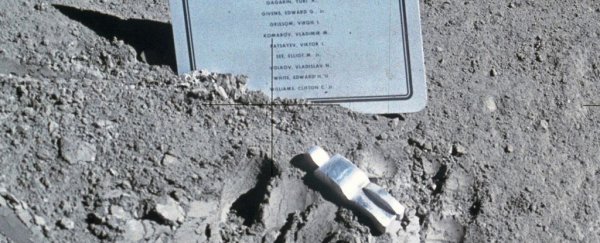On the Moon right now, there lies an aluminium sculpture of an astronaut with a beautiful message.
Called the Fallen Astronaut, it was placed there by Apollo 15 commander David Scott on 1 August 1971 to commemorate all the humans who have died advancing space exploration. The little figurine lies next to a plaque listing the 14 astronauts and cosmonauts who had died to date.
This monument is only 8.5 centimetres (3.3 inches) tall, and although its message is one of honouring sacrifice, the tiny sculpture has also had its fair share of controversy.
The sculpture was designed by Paul van Hoeydonck, a Belgian artist whose work at the time was represented at the Waddell Gallery in New York. The idea belonged to the gallery's director Louise Tolliver Deutschman, who wanted to get art into space.
"It was the Space Age … the race to the stars," she wrote in an unpublished memoir, as Corey S. Powell and Laurie Gwen Shapiro reported in Slate in 2013.
"I kept on contacting people, and I didn't stop until we found a way."
 (Apollo 15/NASA)
(Apollo 15/NASA)
The project was done in secrecy, and it wasn't until after Apollo 15 had landed safely back on Earth that the existence of the sculpture was revealed.
But Van Hoeydonck claims he didn't know that the statue would be used to commemorate astronauts, he didn't approve of the name Fallen Astronaut, and he didn't even intend for the statue to be left lying down.
And instead of being "bigger than Picasso", Van Hoeydonck found himself unnamed as the artist, Scott was the subject of congressional scrutiny after Fallen Astronaut was associated with profiteering off a public space program, and the Waddell Gallery went bankrupt within three years.
Despite all of this, the statue and its message is still incredibly beautiful – and 48 years later, it shows that art even 384,000 kilometres (239,000 miles) away from us is still subject to very human problems.
You can read more about the statue and subsequent controversy in this great feature over at Slate.
